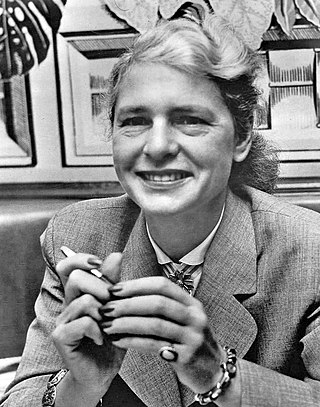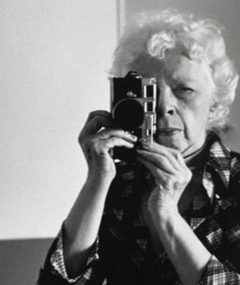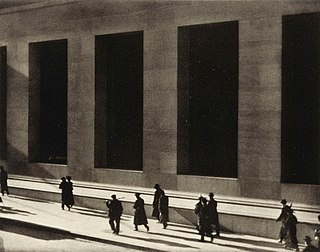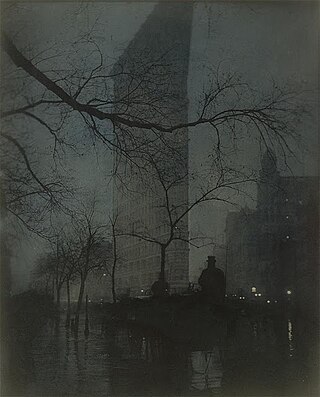
Alfred Stieglitz was an American photographer and modern art promoter who was instrumental over his 50-year career in making photography an accepted art form. In addition to his photography, Stieglitz was known for the New York art galleries that he ran in the early part of the 20th century, where he introduced many avant-garde European artists to the U.S. He was married to painter Georgia O'Keeffe.

Margaret Bourke-White was an American photographer and documentary photographer. She was the first foreign photographer permitted to take pictures of Soviet industry under the Soviets' first five-year plan, was the first American female war photojournalist, and took the photograph that became the cover of the first issue of Life magazine.

Paul Strand was an American photographer and filmmaker who, along with fellow modernist photographers like Alfred Stieglitz and Edward Weston, helped establish photography as an art form in the 20th century. In 1936, he helped found the Photo League, a cooperative of photographers who banded together around a range of common social and creative causes. His diverse body of work, spanning six decades, covers numerous genres and subjects throughout the Americas, Europe, and Africa.

Minor Martin White was an American photographer, theoretician, critic, and educator.

Street photography is photography conducted for art or inquiry that features unmediated chance encounters and random incidents within public places, usually with the aim of capturing images at a decisive or poignant moment by careful framing and timing. Although there is a difference between street and candid photography, it is usually subtle with most street photography being candid in nature and some candid photography being classifiable as street photography. Street photography does not necessitate the presence of a street or even the urban environment. Though people usually feature directly, street photography might be absent of people and can be of an object or environment where the image projects a decidedly human character in facsimile or aesthetic.

Nancy Wynne Newhall was an American photography critic. She is best known for writing the text to accompany photographs by Ansel Adams and Edward Weston, but was also a widely published writer on photography, conservation, and American culture.

Graciela Iturbide is a Mexican photographer. Her work has been exhibited internationally, and is included in many major museum collections such as the San Francisco Museum of Modern Art and The J. Paul Getty Museum.

Lisette Model was an Austrian-born American photographer primarily known for the frank humanism of her street photography.
Robert Hugh Cumming was an American painter, sculptor, photographer, and printmaker best known for his photographs of conceptual drawings and constructions, which layer meanings within meanings, and reference both science and art history.
Miyako Ishiuchi, is a Japanese photographer.

The Steerage is a black and white photograph taken by Alfred Stieglitz in 1907. It has been hailed by some critics as one of the greatest photographs of all time because it captures in a single image both a formative document of its time and one of the first works of artistic modernism.
There were men and women and children on the lower deck of the steerage. There was a narrow stairway leading to the upper deck of the steerage, a small deck right on the bow with the steamer.
To the left was an inclining funnel and from the upper steerage deck there was fastened a gangway bridge that was glistening in its freshly painted state. It was rather long, white, and during the trip remained untouched by anyone.
On the upper deck, looking over the railing, there was a young man with a straw hat. The shape of the hat was round. He was watching the men and women and children on the lower steerage deck...A round straw hat, the funnel leaning left, the stairway leaning right, the white drawbridge with its railing made of circular chains – white suspenders crossing on the back of a man in the steerage below, round shapes of iron machinery, a mast cutting into the sky, making a triangular shape...I saw shapes related to each other. I was inspired by a picture of shapes and underlying that the feeling I had about life."

Wall Street is a platinum palladium print photograph by the American photographer Paul Strand taken in 1915. There are currently only two vintage prints of this photograph with one at the Whitney Museum of American Art and the other, along with negatives, at the Philadelphia Museum of Art. This photograph was included in Paul Strand, circa 1916, an exhibition of photographs that exemplify his push toward modernism.
Walter A. Rosenblum (1919–2006) was an American photographer. He photographed the World War II D-Day landing at Normandy in 1944. He was the first Allied photographer to enter the liberated Dachau concentration camp. He received several military decorations including a Purple Heart. His photography is on display in museums around the world.

The Hand of Man is a black and white photograph taken by Alfred Stieglitz in 1902. This is one of the pictures he took concerning urban life and would be published in the first issue of his magazine Camera Work, in January 1903. A note on this issue stated that “The Hand of Man.. is an attempt to treat pictorially a subject which enters so much into our daily lives that we are apt to lose sight of the pictorial possibilities of the commonplace.”

Akeley Motion Picture Camera is a black and white photograph taken by Paul Strand in 1922. It depicts the innovative motion picture camera that the American photographer bought for $2500 and that allowed him to work in the film industry as a cinematographer until 1931, when the camera became obsolete. Strand took several pictures of the camera and this became one of the most famous.

Bowls, also known as Abstraction, Bowls, is a black and white photograph taken by Paul Strand in 1916. The photograph has elements of cubism and abstractionism, and exemplifies his style at the time.

The Flatiron is a colored photograph made by Luxembourgish American photographer Edward Steichen. The photograph depicts the recently erected Flatiron Building in New York, taking inspiration from fellow photographers like Alfred Stieglitz, who had just photographed the building a year prior. The original negative was made in 1904 and spawned three platinum-gum exhibition prints in brown (1905), blue-green (1909), and yellow-green-black.

Rodin — The Thinker is a pictorialist photograph made by American photographer Edward Steichen in 1902. It depicts renowned French sculptor Auguste Rodin, in his studio, facing his famous The Thinker sculpture, with his other creation, the Monument to Victor Hugo, as a background.

Balzac, the Open Sky is a black and white photograph taken by American photographer Edward Steichen in 1908. The photograph is part of a series created by Steichen that depict the statue of Honoré de Balzac by Auguste Rodin, executed in plaster, in 1898. The statue would eventually be cast in bronze and inaugurated in Paris, in 1939.

Two Shells, also known as Shells, is a black and white photograph taken by American photographer Edward Weston, in 1927. It was part of a series containing 26 photographs of sea shells from the same year, including Weston's famous Nautilus.

















